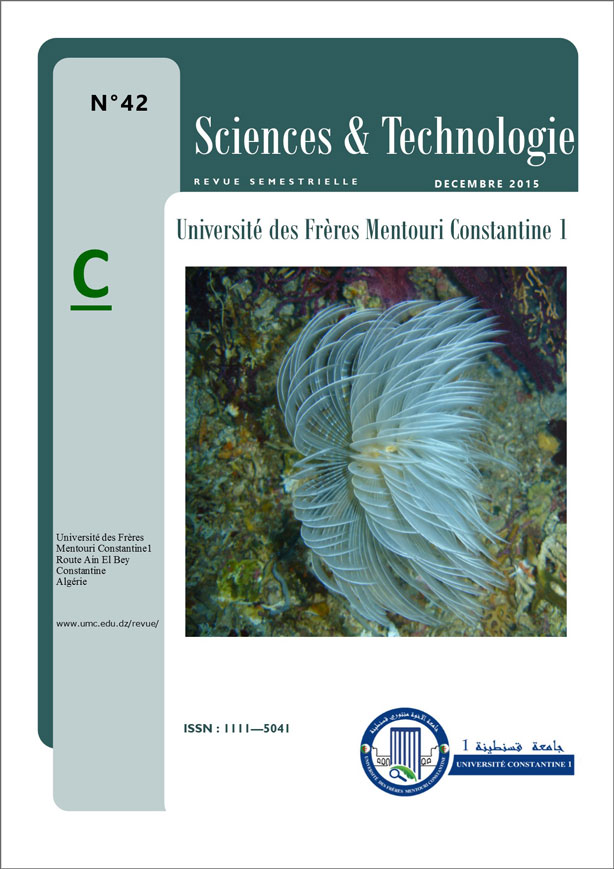EFFECTS OF Rosmarinus officinalis L. AQUEOUS EXTRACT ON ACUTE INFLAMMATION
Keywords:
Inflammation, anti-inflammatory activity, Rosmarinus officinalis LAbstract
In this study, Rosmarinus officinalis L. aqueous extract was evaluated for anti-inflammatory activity by using the model of Carrageenan-induced rat paw oedema. Two doses of the aqueous extract (1500 mg/Kg and 3000 mg/Kg) were given orally by gavage technique, and then carrageenan was injected into the right hind paw of the rat. The extract, which was found rich in phenolic content (196.63 ± 3.09 mg GAE/ g E) and flavonoids (2.22 ± 0.09 mg RE/ g E), has shown a good inhibitory action (44.62 % in the third hour for the higher dose. *: p < 0.1) and close to that of aspirin that was used as a standard (31.87 % in the third hour for 200 mg/Kg aspirin.**: p < 0.05). The same effect was observed macroscopically on the gastric ulcer for both substances. However, the tissue alterations of the stomach were different at the histological study.References
- Al-Sereiti MR, Abu-Amer KM, Sen P, (1999). ‘Pharmacology of rosemary (Rosmarinus officinalis Linn.) and its therapeutic potentials.’Indian journal of experimental biology 37(2): 124-131.
- Bahorun T, Gressier B, Trotin F, Brunet C, Dine T, Luyckx M, Vasseur J, Cazin M, Cazin JC, Pinkas M, (1996). ‘Oxygen species scavenging activity of phenolic extracts from hawthorn fresh plant organs and pharmaceutical preparations.’Arzneimittel-Forschung 46(11): 1086-1089.
- Boudries H, Madani K, Touati N, Souagui S,Medouni S, Chibane M, (2012). ‘Pulp antioxidant activities, mineral contents and juice nutritional properties of Algerian Clementine Cultivars and Mandarin.’African Journal of Biotechnology 11(18): 4258-4267.
- Calixto JB, Otuki MF, Santos AR, (2003). ‘Anti-inflammatory compounds of plant origin. Part I. Action on arachidonic acid pathway, nitric oxide and nuclear factor kappa B (NF-kappaB).’Plantamedica 69(11): 973-983.
- Charles NS, Peter AW andDerek WG, (2010). Fundamentals of Inflammation. New York: Cambridge University Press.
- Ferreira EC, Souza GB, Nogueira ARA, (2003). ‘FIA-FAAS method for tannin determination based on a precipitation reaction with hemoglobin.’Journal of the Brazilian Chemical Society 14(2): 329-333.
- Genena AK, Hense H, Smânia AJ, de Souza SM, (2008). ‘Rosemary (Rosmarinus officinalis): a study of the composition, antioxidant and antimicrobial activities of extracts obtained with supercritical carbon dioxide.’Ciência e Tecnologia de Alimentos 28(2): 463-469.
- González-Trujano ME, Peña EI, Martínez AL, Moreno J, Guevara-Fefer P, Déciga-Campos M, López-Muñoz FJ, (2007). ‘Evaluation of the antinociceptive effect of Rosmarinus officinalis L. using three different experimental models in rodents.’Journal of Ethnopharmacology 111(3): 476-482.
- Gwaram NS, Musalam L, Ali HM, Abdulla MA, (2012). ‘Synthesis of 2’-(5-Chloro-2-Hydroxybenzylidene) Benzenesulfanohydrazide Schiff Base and its Anti-Ulcer Activity in Ethanol-Induced Gastric Mucosal Lesions in Rats.’ Tropical Journal of Pharmaceutical Research 11(2): 251-257.
- Juhás Š, Bukovská A, Čikoš Š, Czikková S, Fabian D, Koppel J, (2009). ‘Anti-Inflammatory Effects of Rosmarinus officinalis Essential Oil in Mice.’ActaVeterinaria Brno 78(1): 121-127.
- Langman MJ, Weil J, Wainwright P, Lawson DH, Rawlins MD, Logan RF, Murphy M, Vessey MP, Colin-Jones DG, (1994). ‘Risks of bleeding peptic ulcer associated with individual non-steroidal anti-inflammatory drugs.’The Lancet 343(8905): 1075-1078.
- Lawrence T. and Gilroy DW, (2007). ‘Chronic inflammation: a failure of resolution?’International Journal of Experimental Pathology 88(2): 85-94.
- Lemonica IP, Damasceno DC, di-Stasi LC, (1996). ‘Study of the embryotoxic effects of an extract of rosemary (Rosmarinus officinalis L.).’Brazilian journal of medical and biological research= Revistabrasileira de pesquisasmédicas e biológicas/SociedadeBrasileira de Biofísica. 29(2): 223.
- Mbiantcha M, Kamanyi A, Teponno RB, Tapondjou AL, Watcho P, Nguelefack TB, (2010). ‘Analgesic and Anti-Inflammatory Properties of Extracts from the Bulbils of Dioscoreabulbifera L. varsativa (Dioscoreaceae) in Mice and Rats.’Evidence-Based Complementary and Alternative Medicine 2011: 40.
- Perretti M. and D'Acquisto F, (2009). ‘Annexin A1 and glucocorticoids as effectors of the resolution of inflammation.’Nature Reviews Immunology 9(1): 62-70.
- Rhen T. and Cidlowski JA, (2005). ‘Antiinflammatory action of glucocorticoids—new mechanisms for old drugs.’New England Journal of Medicine 353(16): 1711-1723.
- Salvemini D, Wang ZQ, Wyatt PS, Marino MH, Bourdon DM, Manning PT, Currie MG, (1996). ‘Nitric oxide: a key mediator in the early and late phase of carrageenan-induced rat paw inflammation.’British Journal of Pharmacology 118(4): 829.
- Scheckel KA, Degner SC, Romagnolo DF, (2008). ‘Rosmarinic Acid Antagonizes Activator Protein-1-Dependent Activation of Cyclooxygenase-2 Expression in Human Cancer and Nonmalignant Cell Lines.’Journal of Nutrition 138(11): 2098-2105.
- Shuai W, Yong-rui B, Yun-Peng D, Xian-Sheng M, Ting-Guo K, (2011). ‘Evaluation of gastric ulcer model based on gray-scale image analysis.’African Journal of Microbiology Research 5(11): 1285-1290.
- Wallace JL, (2008). ’Prostaglandins, NSAIDs, and gastric mucosal protection: why doesn't the stomach digest itself?’Physiological reviews 88(4): 1547-1565.


